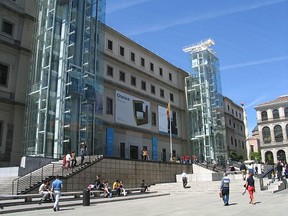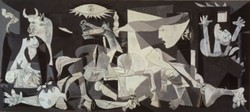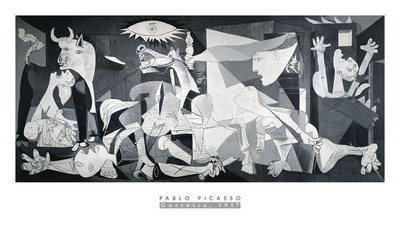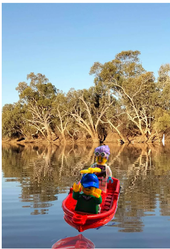How can an artist capture the senselessness of war? How can a painter represent the tragedy of the loss of life, dignity and those valuable things that make living worthwhile? Guernica was an innovative illustration of the effect war had on innocent Spanish civilians. The painting became an icon and has persisted in the memory of a multicultural conglomeration of people, in particular those who have grown up in Europe.
Is it possible to forget the tragic nature of war? This is what the twisted agonized Cubist representation asks people the world over. It is an anti-war symbol, that forces us to think about what it would be like to live in a world struggling to attain peace rather than supremacy.
In this article, I will explain a little about Franco and the Spanish Civil War before unpacking the message of Guernica. It is interesting to note that the painting became so popular as an anti-war statement that when it finally made its way to Spain after a long journey from Paris, and around the world, it was visited by one million people in its first year of display.

Understanding Guernica: Insight into the Suffering Associated with Spanish Civil War
by Jo_Murphy
To understand the monochromatic abstraction of the famous mural Guernica, it is necessary to read about the history of the Spanish Civil War.
Franco and the Spanish Civil War
How could such tragedy happen?
General Franco once said that to save Spain from marxism he was prepared to shoot half the country. (Youtube) Franco was a highly decorated soldier who was rapidly promoted within the Spanish army. During the 1920s, he was a commander in the Spanish Legion and was sufficiently recognised that he became the youngest general in Europe. Franco first came to real prominence with the electoral victory of the conservatives in 1933. He then went on to become Chief of Staff of the military. He was a key figure in the suppression of the anarchist uprising of 1934. When Franco and a group of Spanish military leaders attempted to overthrow the Popular Front it led to a civil war. The way was now open for Franco to emerge as the leader of the Nationalists. He looked to Italy and Germany and with their support combined rebel factions; forming them into the semi-fascist Movimiento Nacional. Franco won the civil war and used his position to dissolve the Spanish Parliament, thus establishing a dictatorship, which would become the nominally restored Kingdom of Spain. He installed himself as Head of State and Head of Government. Franco was able to maintain power in Spain for nearly forty years.
During this time Franco systematically suppressed dissidence via methods of censorship and coercion. He imprisoned ideological enemies in concentration camps, sentencing them to forced labour and utilised the death penalty and heavy prison sentences as a deterrence to opposition.
It was against this backdrop of violence and oppression that the painting Guernica was executed.
A Cubist Masterpiece
Capturing the Senselessness of War
When Pablo Picasso painted Guernica for the Spanish Pavilion at the International Exposition in Paris in 1937, he had seen photographs of the bombing of Guernica in various periodicals. He had read the French newspaper L'Humanité, but rather than paint a realistic scene of the crime, Picasso chose to create a stark and direct to the point, poetic response capturing the ineffable nature of the tragic situation.
The artist chose to limit his palate to monochrome, perhaps alluding to the harsh images portrayed by black and white photographs, the smoky aftermath of the debris and the dour and dark atmosphere of barbarity and terror that the new mechanics of war had now produced. The painting can be read like a giant poster, describing the nature of the atrocity as it had occurred. Picasso was prophetic as he forewarned of the nature of the terrible war to come. He statically displayed distinct symbols that scream out from the canvas, while utilising the power of distortion that Cubist technique lends. Screams sound out the agony of twisted torsos.
There is a bull, with a wounded horse accompanied by a winged bird which formulate a poetic triangle of tension between power and powerlessness. The triad converses with feelings that scream from the canvas as angst erupts from women who are clustered nearby a dead soldier. It is a collage of action snapshots of war. A women holds a lamp as she leans through a window. A mother cries in anguish while holding her dead child. It is a monument chastising the world for creating methods of destruction via newly invented weapons of war and the victims cry to the heavens, flailing helplessly as buildings burn and chaos reigns.
It is the starkness of cubist technique that provides the energy and emotion emanating from this huge overpowering mural, rendering it capable of catalyzing authentic emotion. It is a horrified reaction that acts as a mirror. The opaque surface reflects back to us the same pain we feel when we witness senseless violence at the hand of both terrorists, and governments who react to them with all the more violence. We see the trap within which we swirl as we flounder about in the midst of our modern day confusion. Today, in exactly the same way that Picasso did then, we ask "Why have we created weapons of mass destruction?" What good has this futile blood bath achieved?
 | Guernica: The Biography of a Twentieth-Century Icon Guernica relates the powerful story of Picasso’s 1937 masterpiece, a painting that from its birth out of war and violence became known worldwide as a symbolic cry for peace. The... |
Where is the mural Guernica now?
The long road home
Picasso painted Guernica when he was living in Paris, and he insisted emphatically that his painting not be returned to Spain until until liberty and democracy had been re-established. The mural was therefore housed for exhibition at the Museum of Modern Art (MoMA) after being displayed in Paris.
The painting made it back to Spain, in September 1981, and it was first displayed behind bomb-and bullet-proof glass screens for its protection. Originally the mural was on display at the Casón del Buen Retiro in Madrid. The artistic statement has proved to be incredibly popular as it stands as an iconic testimony to the pride and courage of the people it commemorates. 
The Guernica now attracts crowds who journey to a purpose-built gallery at the Museo Reina Sofía.
Iconic Presence Emanates from a Timeless Portent
Picasso Predicts the Future - weapons that are beyond human control
Across Europe at the time of painting, artists everywhere were reacting to the possibilities new modes of bombing had provided. Mass destruction, and systematic genocide became possible in ways that no-one had hitherto imagined. By the time Hiroshima eventuated, the world was recoiling in shock and horror. And ever since, other nightmares have continued to be invented such as Agent Orange and Germ Warfare.
Cubism was one reaction to this idiotic lunacy, as was Surrealism and later German Abstract Expressionism. Cubism at its core was a poetic expression, Surrealism drilled into the dreamlike, nightmarish aspect of the continuation of events, whilst German Abstract Expressionism almost sank into the abyss of despair.
Today, across the world, we see monuments that have been erected to the "new modes of genocidal violence" that were invented at the time. We seem to have no answer in response to the lunacy these inventions represent.
To understand Guernica, it is necessary to remember that it is a snapshot in time. Look closely and you will see the abstract composition constructed from newspaper print. It was a reaction to the news - caught in a way similar to the brevity but targeted accuracy of Haiku. Bare, raw emotion was stripped of superfluous representation so that all that remained was one lonely, stark scream.
WHY?
You might also like
Artificial Intelligence - a boost or a curse for modern artistsIs the anticipated impact of AI on human-centred innovation hysteria, evidenc...
Ego Leonard - Will you ever come to Australia?Ego Leonard is a Dutch painter and sculptor. His oversized sculptures promine...







 As We Age - We React to Life's Challenges Differentlyon 03/16/2024
As We Age - We React to Life's Challenges Differentlyon 03/16/2024
 Organic Gardening - Cunnamulla Styleon 03/08/2024
Organic Gardening - Cunnamulla Styleon 03/08/2024
 Cunnamulla - Premium Destination Outbackon 12/17/2023
Cunnamulla - Premium Destination Outbackon 12/17/2023
 OpenAI and Watermarkson 02/06/2024
OpenAI and Watermarkson 02/06/2024



Comments
Watching now - it will take me a while to gather my thoughts
Amazing! I am catching up on all this watching!
This page accesses for you the Copacabana lyrics: https://www.google.com/search?q=mikel...
The YouTube versions that I most appreciate of the quite good-looking, quite talented Mikel Izal are the following:
Izal - Copacabana (single) https://www.youtube.com/watch?v=eFN5T...
Izal - Copacabana (video oficial) https://www.youtube.com/watch?v=Btvxv...
Izal - Copacabana (en directo DCODE 2015). https://www.youtube.com/watch?v=HUkpE...
As much as I highly esteem the third option, as a live-concert version, it lacks the mesmerizing dance sequences of Diego Garrido -- starting just over 1.5 minutes into the performance -- past street architecture and art.
La vida misma (translated into English as Life itself)? Mikel Izal (Basque for "respect, shadow") performs Copacabana in Spanish. Internet sources preserve a number of complete performances of that song. I will look this up and follow up the ideas here. I started watching Paddington last night and now I get the connection. Thanks for all this, Jo
Zazpiak bat: the seven [provinces are] one [country]!
Iparralde, as the northern Basque country, comprises the provinces Labourd (Lapurdi), Lower Navarre (Nafarroa) and Soule (Zuberoa).
It constitutes the Basque Municipal Community (Euskal Hirigune Elkargoa, Communauté d'Agglomeration du Pays Basque), along the southwestern France border with northwestern Spain.
Euskadi, as the southern Basque country, comprises the provinces Álava (Araba), Biscay (Bizkaia), and Guipúzcoa (Gipuzkoa).
It constitutes an autonomous community, along with the neighboring Navarre (Nafarroa, Navarra) autonomous Basque province within post-Franco Spain.
Guernica (Gernika) in Bizkay province and Pamplona (Iruña) in Navarre province endure as perhaps the best-known Basque cities.
Gernika houses the tree under which Spanish monarchs promised to respect the separate Basque identity. Pamplona houses the bull runs during The San Fermín Festival (Sanferminak) about which Ernest Hemingway (1899-1961) wrote.
Pamplona is the birthplace of Mikel Izal, Basque musician who lived in Madrid for about a decade and then in Catalan-related Valencia.
Might you have seen the film La vida misma (translated into English as Life itself)? Mikel Izal (Basque for "respect, shadow") performs Copacabana in Spanish. Internet sources preserve a number of complete performances of that song.
When I look it up, I see a question about French or Spanish heritage. Seeds of confusion. Thank you I will follow this up as well.
A television set for me is something that I watch DVDs on even as I generally keep away from series.
Alex O'Loughlin's Hawaii Five-O, Elementary, Jay Hernandez's Magnum PI and NCIS: Hawaii number among the television series that I respect.
Child trauma-survivor art presents itself as an interest because of my having lived in Euzkadi (Basque Country) and knowing about the Gernika orphans.
I have to watch Paddington I forgot but now I remember.
Did I see that episode of the Hawaii Five-O series with Alex O'Loughlin as Steve McGarrett? I think I did. So do you research this?